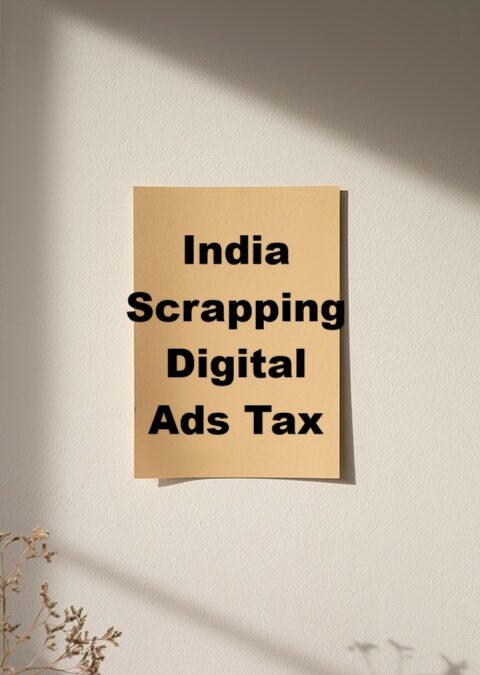India removes digital Advertising Tax
India is set to remove its 6% digital advertisement tax, a move that is expected to bring relief to major U.S. tech companies like Google, Meta, and Amazon. The decision, announced by Finance Minister Nirmala Sitharaman, is seen as a step toward improving trade relations with the United States. This change comes in response to concerns raised by Washington, especially after former U.S. President Donald Trump warned of imposing reciprocal tariffs on countries, including India.
The removal of this tax is part of broader amendments to the 2025 Finance Bill and will take effect from April 1. It aligns with India’s commitment to easing trade tensions and fostering a stronger economic partnership with the U.S. Given that India and the U.S. have set a target of achieving $500 billion in two-way trade by 2030, such policy adjustments play a crucial role in achieving that goal.
For professionals in the digital marketing and e-commerce sectors, this decision could have a significant impact. It not only reduces the cost burden on foreign tech giants but also creates a more favorable business environment for digital advertising.

What Was the Digital Ad Tax and Why Was It Imposed?
India introduced the 6% equalization levy in 2016 as a way to tax foreign digital advertising companies that generated revenue from Indian businesses but did not have a physical presence in the country. This tax was applicable to online advertising services provided by non-resident companies, requiring them to remit the tax to the Indian government.
The objective was to ensure that digital giants operating in India contributed their fair share of taxes, just like domestic companies. However, the United States Trade Representative (USTR) had criticized the tax, calling it “discriminatory and unreasonable,” as it only targeted foreign companies while Indian firms offering similar services were exempt.
In 2021, India had also introduced a 2% levy on non-resident e-commerce companies, which was abolished last year. The recent decision to remove the 6% digital ad tax follows the same trend of easing trade concerns and simplifying tax structures.

Why Is India Scrapping the Digital Ad Tax?
The removal of the 6% equalization levy is primarily aimed at strengthening trade ties with the U.S. and creating a business-friendly environment for foreign tech companies operating in India. The decision was driven by several key factors:
US Trade Pressure: The U.S. government had repeatedly expressed concerns about India’s digital tax, arguing that it unfairly targeted American companies. The threat of reciprocal tariffs by the U.S. prompted India to reconsider the levy.
Boosting Trade Relations: During Prime Minister Narendra Modi’s visit to the U.S. last month, both countries agreed to work toward a phased trade deal by autumn 2025. This move is part of India’s broader commitment to improving trade relations with the U.S.
Encouraging Foreign Investments: Removing the tax makes India a more attractive market for foreign investors, particularly in the technology and digital marketing sectors.
Lowering Digital Advertising Costs: With the removal of the levy, businesses running digital ads in India may benefit from lower costs, potentially making digital marketing more affordable.

Impact on US Tech Giants
The decision to eliminate the tax is a significant relief for U.S. technology firms such as:
Google (Alphabet Inc.) – One of the biggest players in the digital ad market, Google has been subject to India’s equalization levy for years. The removal of this tax is expected to reduce operational costs.
Meta (formerly Facebook) – The social media giant relies heavily on digital advertising revenue in India. The move is expected to benefit Meta’s ad-based revenue model.
Amazon – As a major e-commerce and digital services provider, Amazon will also see cost reductions in its advertising operations in India.
These companies are likely to pass on the cost savings to businesses that advertise on their platforms, making digital advertising more accessible to small and medium enterprises (SMEs) in India.
Implications for Indian Businesses and Digital Marketers
For Indian businesses, especially startups and digital marketers, the scrapping of the 6% digital ad tax presents several key advantages:
✅ Reduced Advertising Costs: With tech giants no longer required to pay the equalization levy, advertising on platforms like Google Ads and Facebook Ads could become more affordable.
✅ More Competitive Digital Ecosystem: Lower ad costs can encourage more businesses to invest in digital marketing, fostering competition and innovation.
✅ Increased Transparency in Digital Taxes: The removal of the tax simplifies compliance for advertisers and aligns India’s tax policies with global digital taxation standards.
However, some experts believe that while this move eases short-term costs, it may lead to discussions on alternative taxation models for digital services in India.

What’s Next? Will India Introduce a New Digital Tax?
While the removal of the 6% equalization levy is a positive step, there is speculation about whether the Indian government will introduce new taxation mechanisms to compensate for the lost revenue. Some possibilities include:
🔹 Global Digital Tax Agreement: India may align its tax policies with the OECD’s global tax framework, which aims to ensure fair taxation of multinational tech companies.
🔹 Expansion of GST to Digital Services: The government could explore widening GST applicability on digital advertising services.
🔹 New Digital Economy Taxes: Future policies may introduce alternative tax structures for the growing digital economy in India.
As discussions continue, businesses should stay updated on regulatory changes to ensure compliance with emerging tax policies.
Conclusion
India’s decision to scrap the 6% digital ad tax is a welcome move that benefits both U.S. tech giants and Indian businesses. It demonstrates India’s commitment to enhancing trade relations with the U.S. while fostering a more competitive and cost-effective digital marketing ecosystem.
For professionals in the digital advertising and e-commerce sectors, this change could result in lower ad costs and better business opportunities. However, businesses must remain vigilant about future tax policy developments as India navigates the evolving landscape of digital economy taxation.
Disclaimer
This blog is for informational purposes only and does not constitute financial, legal, or taxation advice. The details provided are based on the latest available information and are subject to change based on government policies and trade negotiations. Readers are encouraged to consult with a professional tax advisor or legal expert for specific guidance on digital advertising taxation in India. The website www.merijobs.in and its authors do not take responsibility for any decisions made based on the information provided in this blog.


Recent Comments